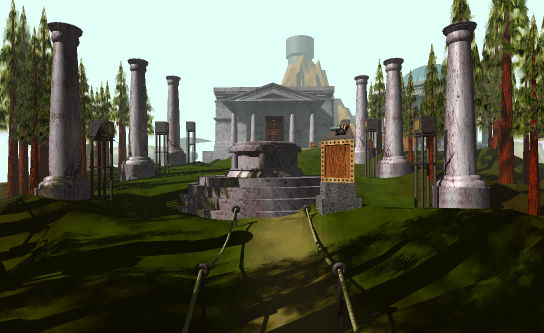|
See below for a History of the Myst series.
What is D'ni? What are Linking Books, or Ages? Read the Uru
Story.
Myst Games
Click to find out more...
History of the Myst series
This is your standard "History of Myst" story - a key story
in the history of computer gaming and multimedia.
Myst was a revolutionary title developed by Cyan
Worlds in 1993. It was one of the original CD-ROM titles, and helped
to bring the CD-ROM medium into the mainstream. It was also the best-selling
game of all time for over eight years (until finally being beaten by The
Sims in 2002). The game was designed by two brothers, Rand and Robyn
Miller, who have since become known as "The Myst Brothers".

Myst Island
In 1997, Cyan released the long-awaited sequel Riven. Riven
continued the Myst legacy, with a rich new story and history, and
a massive new game to explore, around three times the size of the original
game.
Following the success of Riven, Cyan decided to make one final
world - an online adventure. A world that never had to end. Codenamed
"Mudpie" it would take them five more years to see their dream
realised. Unfortunately, Robyn Miller, one of the original designers of
the game, decided to leave Cyan at this point and found a film studio.
From this point on, Cyan was headed solely by Rand Miller.
As a test for Mudpie, Cyan recreated the original worlds of Myst
in full real-time 3D. Named realMyst, it was the ultimate version
of their best-selling product.
In the meantime, to keep fans happy while waiting for Mudpie, Cyan employed
Presto Studios to create the third game, Myst III: Exile. Exile
was the first Myst game to be released under Cyan's new publisher,
Ubi Soft. Sporting new 360° free-look technology, Exile was perhaps
the most immersive of all, telling a story which stemmed from the original
game. However the game didn't sell as well as Myst or Riven,
and most fans don't consider it to be as good as Riven.
Finally in 2003, Mudpie officially became Uru: Ages Beyond Myst,
the game to which this site is devoted. Uru was released in November
with a dramatically different style of play. In full real-time 3D, it
gave the player an avatar, a virtual representation of themselves in the
game, and allowed them to explore in third-person. Furthermore, Cyan's
grand plan, Uru Live, was to have a huge multiplayer world everyone
could explore together, and at the same time, to offer continual updates
over a broadband connection. This was to be offered on top of the single-player
game.
The single-player game was released, and Uru Live was in beta
for some months, but unfortunately, it was cancelled due to lack of funds
in February 2004. Instead, Cyan opted to create single-player expansion
packs to give players the content they had created. To D'ni was
released as a free download in March, and The Path of the Shell
followed in June as a purchaseable product.
Finally, on August 5, 2004, the dream of Uru was finally realised.
Cyan put together a package called Untěl Uru, a modified version
of Uru Live, which allowed community sites and individuals to setup
their own servers and allow Uru players to connect and play the
original game together again.
While all this was going on, Ubi Soft had been secretly working on the
next Myst game (for Uru was technically a spin-off, not
actually a Myst game). Myst IV: Revelation was created in-house
by Ubi Soft's Montreal studios. Revelation goes back to the 2D
pre-rendered images, as used in Myst, Riven and Exile,
but this time, Ubi Soft has added to Exile's free-look engine,
a fully interactive, dynamic, alive world. Everything moves - creatures,
trees, water and the sky. Does it live up to the Myst legacy? There
are those who say "Riven will always be king," and others
who remain skeptical about elements of the game, or its pre-rendered feel.
But many will tell you this is the best Myst ever. However
you feel about it, it is definitely worthy of the name "Myst".
Then, in 2005, came the announcement of Myst V: End of Ages. The
announcement of the final Myst game ever. There would be no more
books, no more Ages, no more Atrus after this. Rand Miller planned to
go out with a bang. Powering-up the 3D engine used for Uru, Cyan
stepped back into the developer's seat for the final goodbye.
On September 20th, 2005, almost exactly twelve years since they revolutionised
the multimedia world with a magical little game called Myst, Cyan
released its epic conclusion. Taking players back to the underground kingdom
of D'ni, players would this time be faced with the monumental decision
upon which the fate of the civilisation rested.
A quiet, peaceful, and alluring game as always, Myst V answered
many questions left hanging from previous games, and tied the series to
a close. After twelve years, six games, and tens of millions of copies
sold, the ending has finally been written.
|